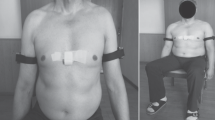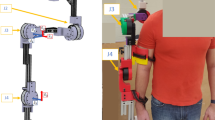Study objective: to determine the kinematic parameters of the shoulder joint in the normal human gait. Materials and methods. A Vicon programmable system for motion capture and analysis was used to study 10 selected men with near-absolute symmetry of upper limb movements. Results. Quantitative measures of kinematic movement parameters at the shoulder joint in the arm transfer cycle during walking were obtained. Flexion-extension and abduction of the upper limbs during the stepping cycle were symmetrical and coincided with the minimal internal rotation only in the middle of the cycle. Swinging of the arms during walking can be compared with the movements of a pendulum with its center at the shoulder joint with a movement amplitude of 24.6 ± 2.4°. Conclusions. The data obtained here serve as standards and provide for comparative analysis of upper limb movements in patients with arm locomotion disorders, and are also of value in prosthetization and robotics.
Similar content being viewed by others
References
O. I. Vorontsova, L. A. Udochkina, I. G. Mazin, and L. A. Goncharova, “The upper limb movement cycle in normal human walking,” Med. Vest. Bashkort. Nauch. Prakt. Zh., 11, No. 6 (66), 53–58 (2016).
D. V. Skvortsov, Clinical Biochemical Analysis of Pathological Gait Using a Programmable System: Author’s Abstract of Master’s Thesis in Medical Sciences, Moscow (1997).
S. M. Bruijn, O. G. Meijer, P. J. Beek, and J. H. van Dieen, “The effects of arm swing on human gait stability,” J. Exp. Biol., 213, 3945–3952 (2010), doi: https://doi.org/10.1242/jeb.045112.
S. M. Bruijn, P. Meyns, I. Jonkers, et al., “Control of angular momentum during walking in children with cerebral palsy,” Res. Dev. Disabil., 32, No. 6, 2860–2866 (2011), doi: https://doi.org/10.1016/j.ridd.2011. 05.019.
M. Ford, R. Wagenaar, and Newell, K., “Arm constraint and walking in healthy adults,” Gait Posture, 26, No. 1, 135–141 (2007), doi: https://doi.org/10.1016/j.gaitpost.2006.08.008.
W. Nanhoe-Mahabier, A. H. Snijders, A. Delval, et al., “Walking patterns in Parkinson’s disease with and without freezing of gait,” Neuroscience, 182, 217–224 (2011), doi: https://doi.org/10.1016/j.neuroscience.2011.02.061.
J. D. Ortega, L. A. Fehlman, and C. T. Farley, “Effects of aging and arm swing on the metabolic cost of stability in human walking,” J. Biomech., 41, 3303–3308 (2008), doi: https://doi.org/10.1016/j.jbiomech.2008.06.039.
S. Rietdyk, “Anticipatory locomotor adjustments of the trail limb during surface accommodation,” Gait Posture, 23, 268–272 (2006), doi: https://doi.org/10.1016/j.gaitpost.2005.03.006.
J. L. Stephenson, A. Lamontagne, and S. J. De Serres, “The coordination of upper and lower limb movements during gait in healthy and stroke individuals,” Gait Posture, 29, 11–16 (2009), doi: https://doi.org/10.1016/j.gaitpost.2008.05.013.
H. Steven, K. Collins, G. Peter, et al., “Dynamic arm swinging in human walking,” Proc. Roy. Soc. Biol. Sci., 276, 3679–3688 (2009), doi: https://doi.org/10.1098/rspb.2009.0664.
B. R. Umberger, “Effects of suppressing arm swing on kinematics, kinetics, and energetics of human walking,” J. Biomech., 41, 2575–2580 (2008), doi: https://doi.org/10.1016/j.jbiomech.2008.05.024.
M. M. Van der Krogt, C. A. Doorenbosch, J. G. Becher, and B. J. Harlaar, “Walking speed modifies spasticity effects in gastrocnemius and soleus in cerebral palsy gait,” J. Clin. Biomech., 24, 422–428 (2009), doi: https://doi.org/10.1016/j.clinbiomech.2009.02.006.
Author information
Authors and Affiliations
Corresponding author
Additional information
Translated from Morfologiya, Vol. 152, No. 6, pp. 67–71, November–December, 2017.
Rights and permissions
About this article
Cite this article
Udochkina, L.A., Vorontsova, O.I., Mazin, I.G. et al. Kinematic Parameters of Movement at the Shoulder Joint in Normal Gait in Humans. Neurosci Behav Physi 48, 903–907 (2018). https://doi.org/10.1007/s11055-018-0647-8
Received:
Revised:
Published:
Issue Date:
DOI: https://doi.org/10.1007/s11055-018-0647-8




